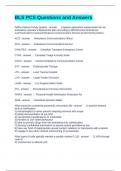-
1. Exam (elaborations) - Peplink certified sales specialist (pcss) questions & answers
-
2. Exam (elaborations) - Pcs exam 2 questions and answers
-
3. Exam (elaborations) - Pcs chapter 18 questions & answers
-
4. Exam (elaborations) - Pcs chapter 13 questions & answers
-
5. Exam (elaborations) - Coding chapter 8 & 9 icd-10-pcs questions & answers
-
6. Exam (elaborations) - Pcs chapter 9 questions and answers 2024
-
7. Exam (elaborations) - Css questions & answers
-
8. Exam (elaborations) - Root operations for icd-10 pcs questions & answers
-
9. Exam (elaborations) - Icd-10-pcs questions & answers
-
10. Exam (elaborations) - Icd-10-pcs coding questions & answers
-
11. Exam (elaborations) - Pcs- coding practice questions & answers
-
12. Exam (elaborations) - Chapter 11 review exam pcs questions & answers
-
13. Exam (elaborations) - Chapter 10 review exam pcs questions & answers
-
14. Exam (elaborations) - Pcs test questions & answers
-
15. Exam (elaborations) - Pcs chapter 16 questions & answers
-
16. Exam (elaborations) - Lu2 pcs questions and answers
-
17. Exam (elaborations) - Intro to icd-10-cm and icd-10-pcs coding questions and answers
-
18. Exam (elaborations) - Quiz 2 icd-10-pcs, code structure, assigning medical and surgical pcs codes questions...
-
19. Exam (elaborations) - Chapter 6 introduction to icd-10-pcs questions and answers
-
20. Exam (elaborations) - Icd-10-pcs questions and answers
-
21. Exam (elaborations) - Html and css knowledge pillar cert questions and answers
-
22. Exam (elaborations) - Chapter 24 pcs questions & answers
-
23. Exam (elaborations) - Icd-10-cm & icd-10-pcs chapter 10 exercise 1- questions & answers
-
24. Exam (elaborations) - Pcs chapter 9 questions and answers
-
25. Exam (elaborations) - Incision and drainage of a cyst of the right auricle is coded as 09900zz removal o...
-
26. Exam (elaborations) - Unit 3/chapter 35 pcs placement section questions & answers
-
27. Exam (elaborations) - Css execution, organization, and responsibilities part 1 questions and answers
-
28. Exam (elaborations) - Css test questions and answers
-
29. Exam (elaborations) - Icd-10-cm & icd-10-pcs ch 1-7 questions & answers
-
30. Exam (elaborations) - Bls pcs questions and answers
-
31. Exam (elaborations) - Icd-10-pcs-week 6 questions and answers
-
32. Exam (elaborations) - Icd-10-pcs review exercise ch 2 questions and answers
-
33. Exam (elaborations) - Icd-10-pcs questions & answers
-
34. Exam (elaborations) - Week 1 introduction to icd-10-pcs questions and answers
-
35. Exam (elaborations) - Uhi lesson 9 icd 10 pcs (optional) questions and answers
-
36. Exam (elaborations) - Bls pcs - section 1 general standards of care questions & answers
-
37. Exam (elaborations) - Introduction to css questions and answers
-
38. Exam (elaborations) - Icd-10-cm & icd-10-pcs chapter 1 review questions and answers
-
39. Exam (elaborations) - Web development - more css questions and answers
-
40. Exam (elaborations) - Pcs exam apta questions and answers
-
41. Exam (elaborations) - Css questions and answers
-
42. Exam (elaborations) - Icd-10-pcs questions and answers
-
43. Exam (elaborations) - Chapters 2, 3, & 6: icd-10-pcs questions and answers
-
44. Exam (elaborations) - Hit 221 mod 1-3 questions and answers
-
45. Exam (elaborations) - Icd-10-pcs overview – questions and answers
-
46. Exam (elaborations) - Binf4216e - icd-10-pcs general terms questions and answers
-
47. Exam (elaborations) - Chapter 49 introduction to icd-10-pcs procedure coding questions and answers
-
48. Exam (elaborations) - Als pcs questions and answers
-
49. Exam (elaborations) - Css questions and answers graded a+
-
50. Exam (elaborations) - Quiz 06 introduction to css questions and answers
-
51. Exam (elaborations) - Html/css review questions and answers
-
52. Exam (elaborations) - W3schools css questions and answers
-
53. Exam (elaborations) - Module 3 css questions and answers
-
54. Exam (elaborations) - Css basics questions and answers
-
55. Exam (elaborations) - Html/css test questions and answers
-
56. Exam (elaborations) - Css/html questions and answers
-
57. Exam (elaborations) - Understanding health insurance key terms chapter 6b questions and answers
-
58. Exam (elaborations) - Homework format and typeface for icd-10-pcs questions and answers
-
59. Exam (elaborations) - Week 2 icd-10-pcs questions and answers
-
60. Exam (elaborations) - Understanding icd 10 cm and icd 10 pcs chapters 1-10 questions and answers
-
61. Exam (elaborations) - Pcs chapter 20 questions and answers
-
62. Exam (elaborations) - Final quiz 5.2 (icd-10-pcs) questions and answers
-
63. Exam (elaborations) - Ch. 3 icd-10-cm and icd-10-pcs coding conventions questions and answers
-
Show more




